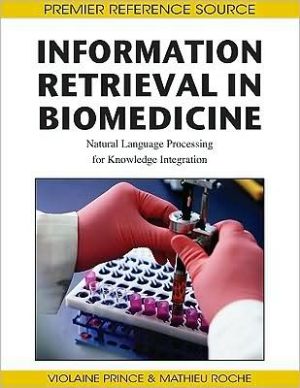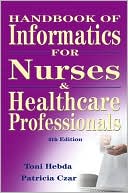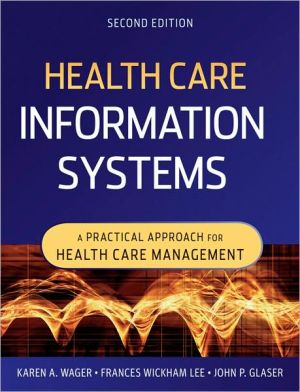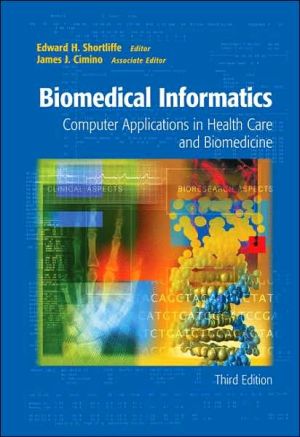Information Retrieval in Biomedicine: Natural Language Processing for Knowledge Integration
Today, there is an intense interest for bio natural language processing (NLP) creating a need among researchers, academicians, and practitioners for a comprehensive publication of articles in this area.\ Information Retrieval in Biomedicine: Natural Language Processing for Knowledge Integration provides relevant theoretical frameworks and the latest empirical research findings in this area according to a linguistic granularity. As a critical mass of advanced knowledge, this book presents...
Search in google:
"This book provides relevant theoretical frameworks and the latest empirical research findings in biomedicine information retrieval as it pertains to linguistic granularity"--Provided by publisher. Doody Review Services Reviewer:Malgorzata Fort, PhD(University of Pittsburgh)Description:This book combines works on information retrieval (IR) in biomedicine using natural language processing (NLP) methods for automated knowledge extraction, integration, and application. It addresses the circular process of mining data using NLP tools, reusing it to enrich and correct the existing structures, which in turn are used to further improve information retrieval.Purpose:Bioinformatics is a hot subject in recent years and the ambitious goal of showing contributions from an NLP perspective as applied to biology and medicine (BioNPL) is quite worthy.Audience:The book is written for advanced readers. The many formulas and equations may make it too difficult to digest for novices. However, it will appeal to researchers interested in natural language processing, artificial intelligence, and linguistics.Features:The introductory essay sets the stage by providing information on text mining services for biomedicine. The closing chapter summarizes some of the achievements investigated in other applications described in this book and serves as an opening window on a new arena where NLP services are needed. In between, the chapters are organized in four main sections. Section I is by far the largest since the research on words, concepts and word-to-word relations is well established. Section II concentrates on research that looks at words in context and investigates broader linguistic granularity to overcome ambiguity of terms. Section III offers works on mining techniques which focus more on structures than on words, on the use of neural network architecture to improve retrieval, and the need in clinical domains, taking the reader from the theoretical to the practical applications of mining techniques. Section IV reviews different NLP software developed and used for IR in biomedicine. While editing seems consistent throughout the book, the last chapter and bibliography leave much to desire: language errors, different dates for the same citation in main text and bibliography, multiple font size inconsistencies and duplicate entries for the same citation in the bibliography. Assessment:Although challenging, this book presents a thoughtful arrangement of works that provide great insight into the field: achievements, current challenges, and the future of dependable automated information retrieval.
Ch. I Text Mining for Biomedicine Sophia Ananiadou Ananiadou, Sophia 1Sect. I Works at a Lexical Level: Crossroads Between NLP and Ontological Knowledge ManagementCh. II Lexical Granularity for Automatic Indexing and Means to Achieve It: The Case of Swedish MeSH Dimitrios Kokkinakis Kokkinakis, Dimitrios 11Ch. III Expanding Terms with Medical Ontologies to Improve a Multi-Label Text Categorization System M. Teresa Martin-Valdivia Martin-Valdivia, M. Teresa Arturo Montejo-Raez Montejo-Raez, Arturo M. C. Diaz-Galiano Diaz-Galiano, M. C. Jose M. Perea Ortega Ortega, Jose M. Perea L. Alfonso Urena-Lopez Urena-Lopez, L. Alfonso 38Ch. IV Using Biomedical Terminological Resources for Information Retrieval Piotr Pezik Pezik, Piotr Antonio Jimeno Yepes Yepes, Antonio Jimeno Dietrich Rebholz-Schuhmann Rebholz-Schuhmann, Dietrich 58Ch. V Automatic Alignment of Medical Terminologies with General Dictionaries for an Efficient Information Retrieval Laura Diosan Diosan, Laura Alexandrina Rogozan Rogozan, Alexandrina Jean-Pierre Pecuchet Pecuchet, Jean-Pierre 78Ch. VI Translation of Biomedical Terms by Inferring Rewriting Rules Vincent Claveau Claveau, Vincent 106Ch. VII Lexical Enrichment of Biomedical Ontologies Nils Reiter Reiter, Nils Paul Buitelaar Buitelaar, Paul 124Ch. VIII Word Sense Disambiguation in Biomedical Applications: A Machine Learning Approach Torsten Schiemann Schiemann, Torsten Ulf Leser Leser, Ulf Jorg Hakenberg Hakenberg, Jorg 142Sect. II Going Beyond Words: NLP Approaches Involving the Sentence LevelCh. IX Information Extraction of Protein Phosphorylation from Biomedical Literature M. Narayanaswamy Narayanaswamy, M. K. E. RavikumarRavikumar, K. E. Z. Z. Hu Hu, Z. Z. K. Vijay-Shanker Vijay-Shanker, K. C. H. Wu Wu, C. H. 163Ch. X Cor'Tag: A Language for a Contextual Tagging of the Words Within Their Sentence Yves Kodratoff Kodratoff, Yves Jerome Aze Aze, Jerome Lise Fontaine Fontaine, Lise 177Ch. XI Analyzing the Text of Clinical Literature for Question Answering Yun Niu Niu, Yun Graeme Hirst Hirst, Graeme 190Sect. III Pragmatics, Discourse Structures and Segment Level as the Last Stage in the NLP Offer to BiomedicineCh. XII Discourse Processing for Text Mining Nadine Lucas Lucas, Nadine 222Ch. XIII A Neural Network Approach Implementing Non-Linear Relevance Feedback to Improve the Performance of Medical Information Retrieval Systems Dimosthenis Kyriazis Kyriazis, Dimosthenis Anastasios Doulamis Doulamis, Anastasios Theodora Varvarigou Varvarigou, Theodora 255Ch. XIV Extracting Patient Case Profiles with Domain-Specific Semantic Categories Yitao Zhang Zhang, Yitao Jon Patrick Patrick, Jon 273Sect. IV NLP Software for IR in BiomedicineCh. XV Identification of Sequence Variants of Genes from Biomedical Literature: The OSIRIS Approach Laura I. Furlong Furlong, Laura I. Ferran Sanz Sanz, Ferran 289Ch. XVI Verification of Uncurated Protein Annotations Francisco M. Couto Couto, Francisco M. Mario J. Silva Silva, Mario J. Vivian Lee Lee, Vivian Emily Dimmer Dimmer, Emily Evelyn Camon Camon, Evelyn Rolf Apweiler Apweiler, Rolf Harald Kirsch Kirsch, Harald Dietrich Rebholz-Schuhmann Rebholz-Schuhmann, Dietrich 301Ch. XVII A Software Tool for Biomedical Information Extraction (And Beyond) Burr Settles Settles, Burr 315Ch. XVIII Problems-Solving Map Extraction with Collective Intelligence Analysis and Langauge Engineering Asanee Kawtrakul Kawtrakul, Asanee Chaveevarn Pechsiri Pechsiri, Chaveevarn Sachit Rajbhandari Rajbhandari, Sachit Frederic Andres Andres, Frederic 325Ch. XIX Seekbio: Retrieval of Spatial Relations for System Biology Christophe Jouis Jouis, Christophe Magali Roux-Rouquie Roux-Rouquie, Magali Jean-Gabriel Ganascia Ganascia, Jean-Gabriel 344Sect. V Conclusion and PerspectivesCh. XX Analysing Clinical Notes for Translation Research: Back to the Future Jon Patrick Patrick, Jon Pooyan Asgari Asgari, Pooyan 357Compilation of References 378About the Contributors 414Index 425
\ From The CriticsReviewer: Malgorzata Fort, PhD(University of Pittsburgh)\ Description: This book combines works on information retrieval (IR) in biomedicine using natural language processing (NLP) methods for automated knowledge extraction, integration, and application. It addresses the circular process of mining data using NLP tools, reusing it to enrich and correct the existing structures, which in turn are used to further improve information retrieval.\ Purpose: Bioinformatics is a hot subject in recent years and the ambitious goal of showing contributions from an NLP perspective as applied to biology and medicine (BioNPL) is quite worthy.\ Audience: The book is written for advanced readers. The many formulas and equations may make it too difficult to digest for novices. However, it will appeal to researchers interested in natural language processing, artificial intelligence, and linguistics.\ Features: "The introductory essay sets the stage by providing information on text mining services for biomedicine. The closing chapter summarizes some of the achievements investigated in other applications described in this book and serves as an opening window on a new arena where NLP services are needed. In between, the chapters are organized in four main sections. Section I is by far the largest since the research on words, concepts and word-to-word relations is well established. Section II concentrates on research that looks at words in context and investigates broader linguistic granularity to overcome ambiguity of terms. Section III offers works on mining techniques which focus more on structures than on words, on the use of neural network architecture to improve retrieval, and the need in clinical domains, taking the reader from the theoretical to the practical applications of mining techniques. Section IV reviews different NLP software developed and used for IR in biomedicine. While editing seems consistent throughout the book, the last chapter and bibliography leave much to desire: language errors, different dates for the same citation in main text and bibliography, multiple font size inconsistencies and duplicate entries for the same citation in the bibliography. "\ Assessment: Although challenging, this book presents a thoughtful arrangement of works that provide great insight into the field: achievements, current challenges, and the future of dependable automated information retrieval.\ \








